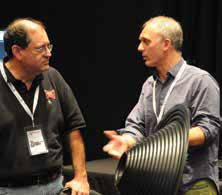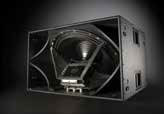Powersoft Highlights New Speaker Magnet Approach

Ah, Italian design. Equal parts performance and aesthetic value, it produces some of the best hardware (machines, race cars) and software (clothing, handbags) in the world. And yet, so the stereotype goes, the culture surrounding this innovation and performance prowess is so laid back as to seem as though the best products come as a result of pure enjoyment in perfecting one’s craft.

Powersoft founder and research development director Claudio Lastrucci explains the M-Force loudspeaker cone design to Mark Sweet, technical services and systems design, Spider Ranch, during Powersoft’s recent roadshow in San Francisco.
Let’s look for an example in the professional audio world. Ah! Powersoft. A company with origins in rugged mobility products for transportation, testing the limits of wireless connectivity since 1995 on buses roaming the streets equipped with GPS and Wi-Fi interconnect and robust telemetry. The company was the brainchild of brothers Claudio and Luca Lastrucci, along with their university friend Antonio Peruch.
Carlo Lastrucci, Claudio and Luca’s father, arrived a few years into Powersoft’s life, having retired from his position as MD for one of the Marconi companies. While Claudio was feverishly refining paradigms from the industrial sector with the alchemist’s touch, Luca was masterminding IT and software, and the third member of the founding partnership, Antonio Peruch, was overseeing quality assurance.
Claudio Lastrucci, now R&D director for the company, and Luca Lastrucci, managing director, built in their garage an extremely efficient audio power amplifier that kinda blew the minds of a lot of touring engineers. They succeeded in doing what others had tried to do before, yet with limited success in making a Class D amplifier perfectly operational and stable for high levels of power. But to hear them tell it, there’s only modest ease and evidence of an earnest desire for continued improvement of their products.

Powersoft’s M-System relies on a new super-driver, M-Force, which suspends neodymium magnets between two coils in a symmetrical front-to-back setup.
Powersoft’s K Series and X Series amplifiers led the way in efficiency, each computer-controlled unit constantly modulating current supply, so they wasted little energy either in an operational or idle state. They saved on tour costs, they saved on rack space, they saved on cooling concerns, and they saved on headaches—especially when the diminutive, high power output, channel-dense, DSP-strong, Wi-Fi-controllable X Series arrived, and allowed operation on any voltage between 85 volts to 440 volts. It’s a universal power supply for the global touring set, operating on a single, bi-phase, or three-phase circuit, so effectively any power that you present to it, anywhere on the planet, will work.
A daily selection of the top stories for AV integrators, resellers and consultants. Sign up below.
But this is all starting to sound far too grandiose for a company that prizes humility, so let’s get back to the science. The amplifiers are out there in the world, and Powersoft continues to innovate on efficiency. These being Class D amplifiers, they can take a cue from the hybrid car engine and essentially do something similar to dynamic braking, where energy is recycled back into the car’s power supply.
In the realm of amplifiers, this pertains to a phenomenon called “back EMF,” which is extraneous energy generated by a moving speaker cone. Powersoft recaptures that back EMF and uses it to recharge storage capacitors within the amplifier, provide a bit of onboard storage for instances requiring extra power.
Along those same lines, Powersoft has been exploring ways to overcome the heat and mechanical limitations presented by the historical design of loudspeakers. Looking specifically at subwoofers, the large size of which test the limits of heat and durability the most profoundly, Powersoft engineers wondered if there was a way to move away from the traditional moving coil to a moving magnet approach instead. And the M-Force was born.
Essentially a new super-driver, M-Force suspends neodymium magnets between two coils in a symmetrical front-to-back setup. A polarity change in the coil moves the magnet generating tremendous force with little wasted energy. It’s so efficient that it requires its own amplifiers based on switching-mode technologies, called the M Drive.
The results are fairly stunning to witness, and Powersoft’s recent road shows in Los Angeles and San Francisco generated serious excitement, as the M-Force was unleashed in a prototype subwoofer design for the first time. The technology has been available to Powersoft R&D developers for about two years, but the time has come to show the power of this thing.
Watch for its appearance in a city near you, starting with a stint in the Northeast the week of March 21.
Kirsten Nelson is editor-at-large at SCN.
